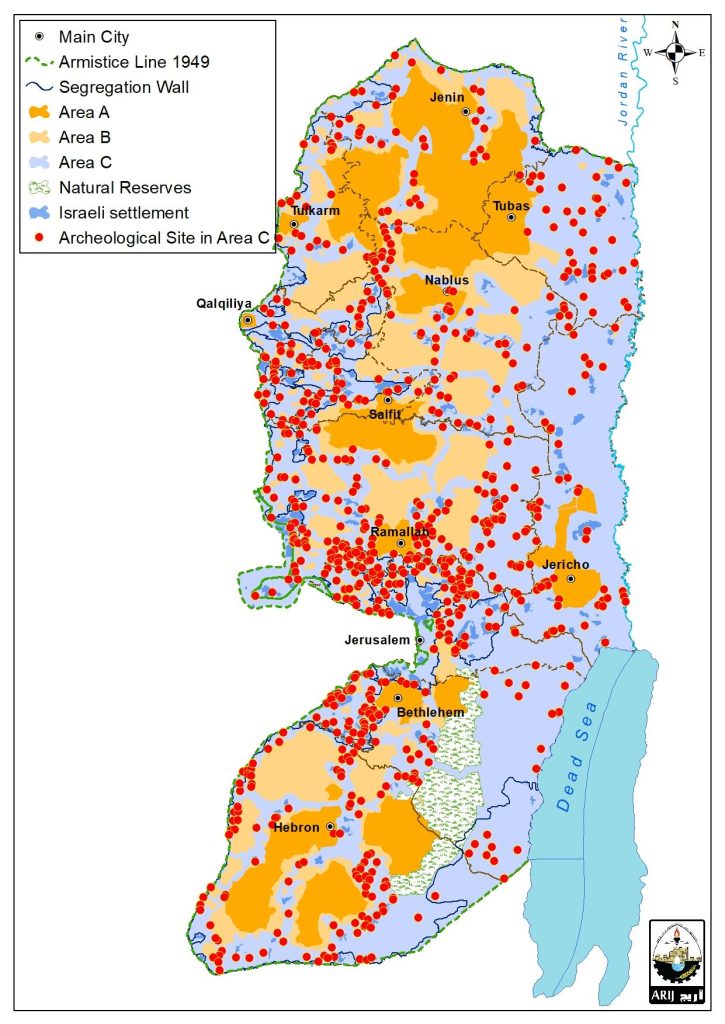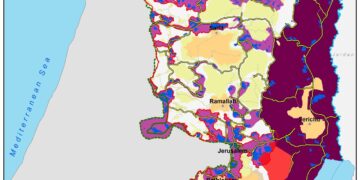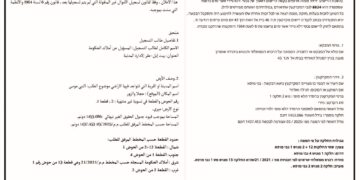The consequences of Israel’s decision to preserve archaeological sites in Area C in the West Bank
On July 18, 2023, the Israeli Government gave its approval to a new plan that would see the rehabilitation and preservation of heritage and archaeological sites in Area C of the occupied West Bank. The plan, as stated, has been allocated a significant budget of $33 million, to bolster the protection of what are referred to as “Israeli archeological and heritage sites” in the occupied West Bank which. The plan will also include the use of surveillance cameras, drones and other necessary technologies for that purpose; citing that, such investment is needed “to stop the large-scale looting and destruction of archaeological sites carried out by the Palestinian Authority”, as claimed.
Map 1: Archeological Sites in Area C of the occupied West Bank
Israel’s decision to preserve archaeological sites in Area C of the oWB is a matter of significant concern to Palestinians. The West Bank, under the Oslo Accords, was divided into 3 zones: Area A[1], B[2], and C. Area C, makes up 61% of the WB, and it is under the full Israeli civil and security/military control. These area assignments were meant to be temporary, with land being phased into total Palestinian control by the end of the five-year interim period as designated by the Oslo Accords, which was set to end with final status negotiations in 1999.
Area C is rich in its natural resources and has many touristic and archaeological sites, water resources from water wells and Codeines Dead Sea minerals and cults and Stone (including marble deposits). Area C has also the potential for significant urban expansion to accommodate Palestinian population growth and economic development needs. However, in spite of its acknowledged importance for sustainable development in Palestine and for establishment of a sustainable Palestinian State, the Palestinian Authority has no security administrative control over this area. Rather, Area C is under the full Israeli military control and Palestinian development in Area C requires approval by the Israeli Civil Administration. As of 2023; Israeli military zones occupied 29% of Area C, and Israeli settlements occupied 6% of C and these continue to spawn and expand.
By preserving archaeological sites in area, “C” in the oWB, Israel illegally asserts its historical ties to the land, and this action has severe implications for the Palestinian people on various levels – geopolitical, cultural, social, and humanitarian and the prospects for peace, and the preservation of cultural heritage.
On the Cultural Heritage and Identity, preserving archaeological sites in Area C reinforces Israel’s narrative of historical connection to the area as it aligns with its own agenda to solidify its control of the area. While acknowledging the significance of preserving cultural heritage, it is essential to recognize the impact on the Palestinian cultural identity. Palestinians also have deep-rooted historical and cultural ties to the land, and unilaterally preserving these sites from Israel’s perspective is perceived as an attempt to erase or downplay Palestinian history.
Regarding land ownership and annexation concerns, Israel’s decision constitutes a provocative assertion of its sovereignty and control over the area, using archaeology as a means to solidify its claims. The strategic use of archaeological preservation provides Israel with the basis to establish Israeli settlements, thereby deepening the potential for annexing Area C. As a consequence, this approach significantly impedes the establishment of a feasible Palestinian state with territorial contiguity, presenting considerable challenges to the realization of such a state.
Humanitarian Impact on Palestinian Communities
The Israeli focus on preserving archaeological sites can hinder Palestinian development and infrastructure projects in Area C in the oWB as it involves strict regulations and restrictions on Palestinian construction and development in the surrounding areas. Israeli occupation authorities impose zoning and building regulations that limit Palestinians ability to build homes, schools, and infrastructure necessary for sustainable living, creating obstacles for Palestinian communities and impeding their economic growth and well-being as it can lead to forced displacement, increased poverty, and limited access to basic services, exacerbating the already challenging situation in the occupied West Bank.
To conclude,
Actions such as preserving archaeological sites in Area C of the occupied West Bank escalates tensions and creates obstacles to any future peace negotiations. It is a unilateral move undermining the potential for a negotiated two-state solution and further diminishing the trust between the two sides.
Israel aims to bolster its claims to the land and legitimize the construction of Israeli settlements, outposts and other settlement activities, which will result in the expropriation of more Palestinian lands and the displacement of more Palestinian communities; thus hindering the establishment of a contiguous and viable Palestinian state.
International Law and Violations
The preservation of archaeological sites in Area C violates international law.
- Article 53 of the 1949 IV Geneva Convention[3] stipulates that: “Any destruction by the Occupying Power of real or personal property belonging individually or collectively to private persons, or to the State, or to other public authorities, or to social or cooperative organizations, is prohibited, except where such destruction is rendered absolutely necessary by military operations.”
- Art. 23. (g) of Laws and Customs of War on Land (Hague IV); October 18, 1907 states that: “To destroy or seize the enemy’s property, unless such destruction or seizure be imperatively demanded by the necessities of war.”
- Oslo II states in Article XXXI(7), “Neither side shall initiate or take any step that will change the status of the. West Bank and the Gaza Strip pending the outcome of the permanent status negotiations
The unilateral preservation of Archeological sites in area C by Israel without involving Palestinian authorities is deemed as a violation of international law.
[1] Area A, which is made up of the Palestinian city centers (excluding Hebron) is under Palestinian civil and security control
[2] Area B, which is made up of the Palestinian built-up areas outside Area A, is under Palestinian civil control and joint Israeli and Palestinian security control, though Israel has exclusive right to enter Areas B to conduct “security operations” as it wished
[3] Convention (IV) relative to the Protection of Civilian Persons in Time of War, Geneva, 12 August 1949, Article 53
Prepared by:
The Applied Research Institute – Jerusalem














